I don't see any mention of dwarf conifers anywhere? Does no one like them?
Comments
Huh. Well, look here. http:/
Huh. Well, look here:
http://paridevita.com/2013/01/23/trip-to-jerrys-nursery/
I live down the street, more or less, from Jerry Morris. I was really thinking about building a wooden trough, since I didn't feel like making yet another hypertufa one, and there's a long wooden trough in the pictures in the above post. I might not make one that long ...
So I was really thinking about two things at once (two more than usual, for me). Most of Jerry's conifers stay small.
Oh! That's a great place! We
Oh! That's a great place! We are both bonsai fans too - so the idea of being able to buy those trees already begun on their journey to Jin with the driftwood/deadwood pieces is really tempting. I've only recently stopped hyperventilating over the totally glorious conifers I saw in the Czech Republic. Darn things were growing like little green ( and blue and grey) weeds!
It really is an amazing place
It really is an amazing place. Or was. I'm not sure of the status of the nursery these days. The pictures were taken quite a while ago, at the plant sale of the Rocky Mtn. Chapter of NARGS, and I should have brought (should have had, in order to bring) thousands of dollars.
I did manage to get a few cultivars of Picea pungens which are not in commerce. Here's a picture, taken a few minutes ago, showing 'Haley's Blue' (which is available), and then, continuing to the right, 'Clark's Tiny', MU 92, and 319. At extreme right is a Pinus ponderosa, in the trough, which is at least twenty years old.
And a close-up of 319. Apparently this one, like MU 92, wasn't good enough to get a name.
We find Picea pungens are
We find Picea pungens are very susceptible to aphid attack here - can that be a problem for you in Colorado?
It's too cold for aphids here
It's too cold for aphids here......
But no, aphids aren't a problem. Spruce budworm is, but that keeps the plants smaller, and there's a wasp that feeds on the budworm.
"Spruce budworm" isn't a term
"Spruce budworm" isn't a term familiar to me - had to look it up - we do get chomping critters on conifers but I'm not expert enough t say if they are those exact beasts. Here they don't keep plants small as such....... they just mess them up thoroughly, denuding sections at great speed.
Seems your budworms are species of Choristoneura while our problem chompers are usually sawflies - Neodiprion sertifer
These things bore into the
These things bore into the new growth, and kill it. Like "candling" the conifers, sort of. The dead growth can be snapped in half, revealing the larva, at which point a wasp comes by, and that's the end of that.
I don't talk about this too much lest one of my spray-happy neighbors gets an idea in their head.
Here's a middling-quality picture of Picea engelmanii 'Eagle River', another one of Jerry's. (Incidentally, the container--not the tree--has been outdoors for about fifty years, but only recently--this century--began to crack.)
Okay - that's a form of
Okay - that's a form of attack "our" critters don't seem to use ( hope I didn't speak too soon.
"Candling" is something that takes quite a bit of time here as we do our share to keep things in proportion to their allotted space. A simple technique which I am surprised more folks do not employ on their garden pines.
I had already noted your blue ceramic pots - we have a selection of those here , too, which look very similar - we have square and round types too. I guess ours probably date from the early to mid 1980s - no casualties so far, not even in the 9 plus weeks of minus 19 degrees C the other year - which was a pleasant surprise( the lack of pot damage, not the cold weather!!)
Is your area free from Cooley
Is your area free from Cooley spruce gall adelgids, Bob? They occur here though it is much colder than your area (they are not generally devastating, so far as I know). We had a small infestation on a spruce when we lived up in Edmonton.
Candling is work, which is
Candling is work, which is why none is done around here, any more.
The pot on the left, of the four, is a recent purchase. Well-made, and very heavy. I bought a number of these for dwarf conifers, but never got the conifers, so most stay empty.
The roots of Picea pungens, by the way, are hardy to -100F, if not much lower.
I've heard of them..... There
I've heard of them..... There isn't any place on this continent that's colder than my garage, by the way.
Here's another picture, also middling-quality, of an unnamed Pinus flexilis growing out of a trough, and not being as dwarf as it ought to be.
The American Conifer Society
The American Conifer Society size classifications for dwarf plants can be misleading. A dwarf conifer can grow 3 inches a year. In 10 years it could be 30 inches bigger in all its dimensions. A 12 inch plant after 10 years could be 6' across and 31/2' tall. In my rock garden plantings I try to select a plant that grows less than an inch and preferably less than a half inch a year. Some growers are beginning to add annual growth rates in their descriptors. I have a 60 year old Hinoki that is 30 inches across and 24 inches tall with a trunk caliper of 3 inches...A perfect miniature tree with an annual growth rate of less than 1/4 inch. This plant has not been pruned or clipped in anyway. Its bonsai without all the art, fuss and work.
Such plants are becoming more available. They are expensive. To grow a softball size plant that will sell can take 10 years which is a large investment in time and space for a grower. There are, however, some readily available and not too costly miniature conifers. Two excellent Hinoki (Chamaecyparis obtusa) miniatures are 'Tsukumo' & 'Leprechaun'. Juniperus communis 'Blue Pygmy' is a bit larger at 1/2 per year. Picea abies 'Wichtel' does 1/4 inch a year.
Adding such miniature conifers to a rock garden adds an interesting and attractive contrast to an alpine display. Do not fertilize these miniatures. Plant in a lean, alpine grit (perhaps 10% organic matter).
gpk
Hinokis last about ten
Hinokis last about ten minutes here .....
A few more pictures. First, a Pinus flexilis from Taos. Then Picea pungens 'J. James'. (This is available in the trade.) Then two examples of Pinus monophylla grown from broom seed, showing different, weird rates of growth. Lastly, Pseudotsuga menziesii var. glauca, 87 (no name, just a number). This last suffered a bit from the May hailstorm. All from Jerry Morris.
My first attempt at the forum
My first attempt at the forum...I think I was just trying to address the entire conifer thread re "dwarfs" and trying to give some size selection guidelines. I agree that Hinokis are not hardy much below USDA zone 5. There are, however, nice miniatures in most Conifer Genera. Many are hardy to extreme low temperatures. Picea pungen miniatures are an especially good selection for containers and extreme cold as you indicated. P. pungens is not a good candidate for anything above USDA Zone 7 due to pests not being killed by lower temperatures. I've had no problems with P. pungens in Rochester, NY at USDA zone 6. Folks can't grow it in North Carolina at zone 7 due to "bagworm" infestation. Our winters are apparently just a bit too cold for bagworms.
Colorado at high elevation presents some difficulty in finding selections. Tsuga canadensis (hemlock) is hardy to USDA zone 2 but would certainly succumb to only 30cm of rain a year and your low winter humidity. Jerrry Morris also did some selections of Pinus aristata. (I have one called 'Silver Bee' that has grown 4 " in ten years.)
I was surprised to see your Pseudotsuga . I lost a beautiful 8' 'Emerald Twister' last winter due to the "Polar Vortex". The tree just "freeze dried" in the relentless 30mph winds, 10 degree F. temperatures, and bright sunshine. It would seem hardy enough but my conifer buddies tell me that it is native to a maritime climate with cold but moister conditions and what we had last winter was just too dry for it.
I think all of this shows that many factors (some not so obvious) can determine the success of a conifer. However, the quality that a miniature conifer can bring to a rock garden is worth a little experimenting.
gpk
.
I definitely agree with the
I definitely agree with the last sentence. They also make the garden a lot more interesting in winter.
DBG has a number of chamaecyparis but, being farther east, they are protected from the winds coming off the Continental Divide, and they're planted in areas where they're also protected from our hot winter sun.
The pseudotsuga pictured is one of Jerry's; the native subspecies, not the one from farther west. I did lose a beautiful specimen of 'Vail' last winter, but that was after I brilliantly decided to transplant it. Also have a dwarf--dwarfish--Pinus aristata with no name.
Welcome to the forum, 1000176
Welcome to the forum, 1000176. I have to say, I've never said that to a bunch of number digits before....
You're definitely right that "dwarf" has always been a relative term, and I'll bet those really slow growers of Bob's would grow a bit faster in my climate with more rainfall (if they like it). Heck, the dwarf apples that are available here in Minnesota grow half to two-thirds of normal, so that means 20+ feet. I don't have any miniature confers anymore, since I killed my two Tsuga from neglect. But I do have some dwarfs:
About 15 years old, Larix decidua. Dwarfed by the pot size. Gotta love that bark! A Cerastium alpinum volunteered in the pot.
Picea abies 'Parsonii', 30 years old. In the upper left, a bit of species Thuja koraiensis.
Picea omorika 'Triblitzch', 10 years.
Absent in the trade now is the original Chamaecyparis pisifera 'Filifera Nana'. It is still showing last winter's dieback: the first winterburn ever in its 18 years of life in full sun. The strong March sun, especially after a heavy snowfall as in this case, is the worst thing that can happen to a conifer here.

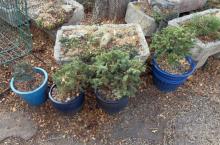
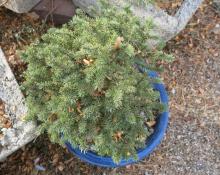
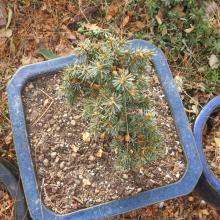
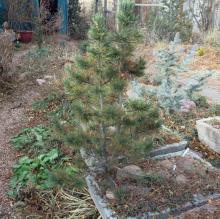
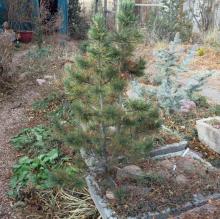
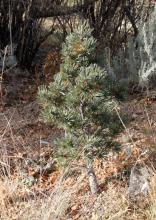
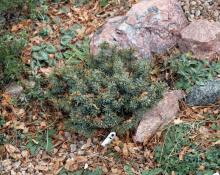
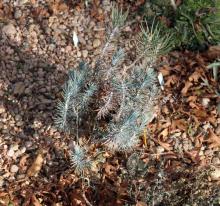
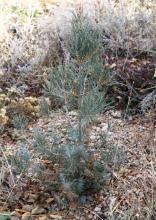
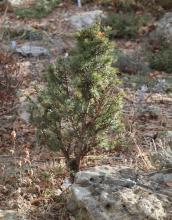
I think quite a lot of folks like 'em, Bob. And the Czechs in particular are just crazy for Witches' Brooms and these plants were very popular purchases, being ferried homewards by all manner of visitors after the Czech Conference in 2013. Some of the gardens where these are displayed are quite magical places. I fear that in the USA, as in the UK, there have been so many people "burned" by the purchase of "dwarf" conifers that have turned out to be no such thing, that these plants have been largely side-lined- at least as far as discussing them is concerned.
Too often such plants turn out to be merely slow-growing, or worse, slow-growing but only for the first few years! The dwarf conifer lasses at the alpine plant shows in the UK are usually quite well-supported ( though not all the entries are truly dwarf ) and can show some really choice little trees. They're just "unfashionable" I guess!
) and can show some really choice little trees. They're just "unfashionable" I guess!